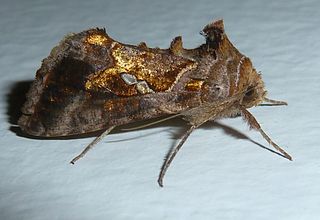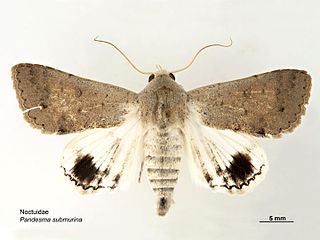
The Noctuidae, commonly known as owlet moths, cutworms or armyworms, are a family of moths. They are considered the most controversial family in the superfamily Noctuoidea because many of the clades are constantly changing, along with the other families of the Noctuoidea. It was considered the largest family in Lepidoptera for a long time, but after regrouping Lymantriinae, Catocalinae and Calpinae within the family Erebidae, the latter holds this title now. Currently, Noctuidae is the second largest family in Noctuoidea, with about 1,089 genera and 11,772 species. This classification is still contingent, as more changes continue to appear between Noctuidae and Erebidae.

Schinia, commonly called flower moths, is a large genus of moths belonging to the family Noctuidae. The genus has a Holarctic distribution with the vast majority of species being found in North America, many with a very restricted range and larval food plant.
Camptoloma is a genus of moths in the family Nolidae. It was formerly incorrectly placed in Arctiidae.

The tomato looper or golden twin-spot moth(Chrysodeixis chalcites) is a moth of the family Noctuidae, subfamily Plusiinae. It mainly lives in southern Europe, the Levant and tropical Africa, but can be seen migrating across much of Europe. In 2013, it was spotted in Canada. It is an important horticultural pest in New Zealand.
Aumakua is a genus of moths of the family Noctuidae, consisting of one species Aumakua omaomao, which is endemic to Hawaii.
Cyptonychia is a genus of moths of the family Noctuidae.

Pandesma is a genus of moths in the family Erebidae. The genus was erected by Achille Guenée in 1852.
Abagrotis orbis, the well-marked cutworm or Barnes' climbing cutworm, is a moth of the family Noctuidae. The species was first described by Augustus Radcliffe Grote in 1876. It is in southwestern North America, extending eastward across the plains and with a large disjunct population in dune habitats in the southern Great Lakes area. It extends into western Canada only in the southern interior of British Columbia and southern Alberta and Saskatchewan.

The Erebinae are a subfamily of moths in the family Erebidae erected by William Elford Leach in 1815. Erebine moths are found on all continents except Antarctica, but reach their greatest diversity in the tropics. While the exact number of species belonging to the Erebinae is not known, the subfamily is estimated to include around 10,000 species. Some well-known Erebinae include underwing moths (Catocala) and witch moths (Thermesiini). Many of the species in the subfamily have medium to large wingspans, up to nearly 30 cm in the white witch moth, which has the widest wingspan of all Lepidoptera. Erebine caterpillars feed on a broad range of plants; many species feed on grasses and legumes, and a few are pests of castor bean, sugarcane, rice, as well as pistachios and blackberries.

The Museum Witt Munich (MWM) is a department of the Bavarian State Collection of Zoology. It is located in Munich, Germany, and has the world's leading collection of moths.
The Micronoctuini are a tribe of moths in the family Erebidae that includes about 400 described species. Typical species in the tribe have bifine hindwing venation and are smaller than those in other noctuoid moths. Micronoctua karsholti is the smallest of all species in the superfamily Noctuoidea.
The Micronoctuina are a subtribe of moths of the family Erebidae erected by Michael Fibiger in 2005.

Pandesma submurina, the pale migrant, is a moth of the family Erebidae first described by Francis Walker in 1865. It is found in Australia in New South Wales, the Northern Territory, Queensland and Western Australia.
The Pandesmini are a tribe of moths in the family Erebidae.
Pandesma decaryi is a moth of the family Erebidae. It is native to central & south-western Madagascar.
Emilio Berio was an Italian entomologist and lawyer.
Poliosia muricolor is a moth in the family Erebidae. It was described by Francis Walker in 1862. It is found on Borneo and in Singapore and India. The habitat consists of lowland forests.
Pandesma quenavadi is a moth of the family Noctuidae first described by Achille Guenée in 1852. It has a wide distribution and is found in African countries such as the Democratic Republic of the Congo, Egypt, the Gambia, Kenya, Madagascar, Malawi, Namibia, Somalia, South Africa, Sudan, Tanzania, Uganda, Zambia and Zimbabwe. It is also found in South Asian and South East Asian countries like Sri Lanka, Bangladesh, Taiwan, Myanmar, Thailand, Sumatra, Borneo, Java, the Philippines, Australia and Japan.







